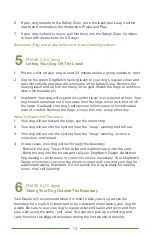
14
Adjusting the Receiver Collar
Your DogWatch Dealer has installed your DogWatch Hidden Fence, set the
Transmitter and receiver to the training levels appropriate for your dog’s personality
and traits, and has placed boundary flags around the perimeter of your yard. Your
Dealer has already begun your dog’s first day of containment training. Now it is your
turn to continue the training. Be sure to place the DogWatch collar on your dog’s
neck before you go outside to begin training.
1. The collar should be worn snugly on the dog’s neck.
This is extremely important!
2. Place no more than one thumb width between the
contact post and dog’s neck.
3. When checking snugness of collar, the dog’s neck
should be facing down (sniffing position) as this
is where the dog’s neck is the smallest.
4. If the collar is too tight or is worn for prolonged
periods of time, it can cause skin irritation and sores
(necrosis.)
5. If the collar is too loose, the dog will not receive
the intended correction if he wanders into the
Avoidance Zone.
6. Remember to periodically check for irritation
around the dog’s neck.
7. DogWatch strongly recommends that the collar be
removed daily and when the dog is inside the house.
Safety and Avoidance Zones
1.
SAFETY ZONE:
This is the area where the dog is free to play.
2.
AVOIDANCE ZONE:
The Avoidance Zone is the area between the flags and the
boundary wire where there is a signal created by the wire. When your dog crosses
into the signal field, the receiver collar emits an audible warning (or a vibration
warning if it is a vibration receiver.) If your dog continues to move toward the
boundary wire after hearing the warning beeps, he will receive a correction.
Checking the collar
Safety Zone
*Training teaches your dog to stay in his Safe zone.
Boundary Wire
Avoidance
Zone
Contact Posts
must touch skin
Adjust
collar strap
Содержание ProFence
Страница 1: ...Owner s Guide ProFence ...









































